Solomon Islands: Be Prepared for Adventure
After leaving the cultural experiences of Vanuatu behind, James Ashwell and his crew headed for the Solomon Islands. What they found were some of the most “off the beaten track” places and memorable adventures of their five-year Pacific crossing, as James details in another comprehensive report for Noonsite.
Published 6 months ago
Our time in the Solomon Islands, I would have to say, was a massive highlight of our five years cruising the Pacific. It is incredibly wild and undeveloped and while you have to do it cautiously, don’t be afraid to do it.
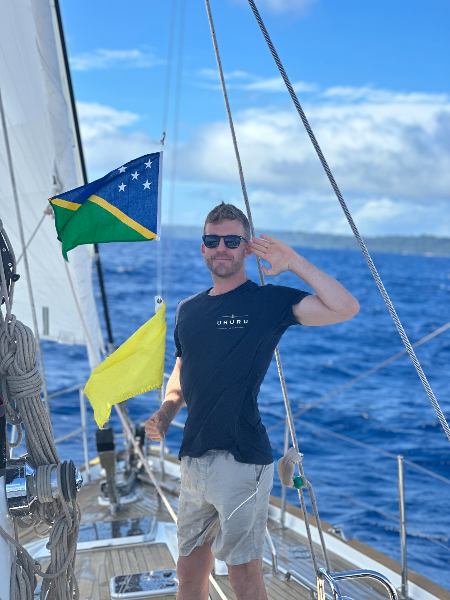

It’s very different to Vanuatu. There you can do what you want and there’s a tourism infrastructure to support visitors. For instance, if we wanted to climb a volcano we would call up a tour company on the phone, tell them “hey we really want to climb a volcano” and the next morning there would be a guide on the beach and we’d climb the volcano. The following morning we’d do a village tour and there would be naked dancers in banana leaf skirts – it was incredible and we felt as safe as houses.
The Solomon Islands isn’t like that – it’s way more adventurous. We saw one other boat in the month we were there and the customs officials told us 30 boats visited last year, so you really feel like you’re doing something that is totally off the beaten track and that few others are doing. We were told that we were boat Number 10 for the year when we arrived in Lata! It’s my type of sailing and exploring, but I wouldn’t rate it above Vanuatu because Vanuatu is fun and cultural and quite easy, while the Solomon Islands feels so wild and untouched.
Out of the pages of National Geographic
The two countries are amazing places to visit for different reasons – one is an unbelievable cultural hotspot and the other is geographically wild and crazy. You’re on your own in the Solomon Islands – it feels like something straight out of Jurassic Park. It’s like the pictures in National Geographic magazine years ago, but we were seeing the same thing in 2023.
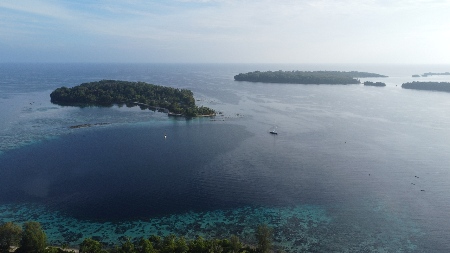

Plan ahead
I hope people will think again about visiting the Solomon Islands, it is amazing but you can’t be business as usual – you have to be prepared. I planned it all out because I love planning and it was all worthwhile. We had heard stories about it being unsafe but we planned our route, downloaded satellite images of potential anchorages and emailed places at each anchorage in advance so our arrival was expected.
An important note for anyone considering visiting the Solomon Islands – and I hope others decide to visit – is that you should always go ashore when you arrive at an anchorage, find the village chief or headman and ask permission to stay.
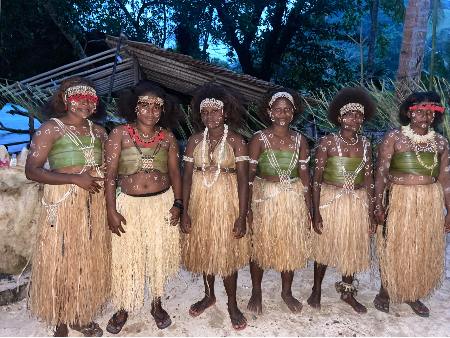

Do not just drop anchor, remember you are in someone’s back yard. Having a trading box of gifts is a good idea too. Once you have made friends with the Chief and shown your respects by asking permission and the giving of gifts, you have – inadvertently – made them a little responsible for the safety of their new foreign visitors. We found this safety net was very important and allowed us to relax in each location and sleep well at night.
Wherever we went diving we paid US$5 per diver to the local village, which was the accepted going rate already established by the live-aboard dive boats.
It has been by far the most remote place we will go to and because of a bit of luck and good planning, we have had an amazing time which I think will be the highlight of our circumnavigation.
Lata
We cleared into the Solomon Islands at Lata. There is a small bay to the east of Graciosa Bay just below Shaw Point on Navionics charts.
This appears to be the best bay to anchor in when clearing in or out at Lata. It was recommended to us by the customs and immigration officials. When we arrived there we found a beautiful bay with good holding in 15m in the middle and 10m on the sides. The bay is well protected from all but strong SW winds. The protection is so good that an American has left his yacht there for the past eight months and it still had a surfboard and kayaks strapped to the sides!
We emailed customs and immigration officials a week before we arrived and submitted all the forms electronically. They seemed happy that we had emailed them with our ETA the day we arrived and to my surprise they greeted us as we anchored in the bay.
Clearances took a few minutes and cost nothing (as there is no way to get local currency in Lata!). It was probably the most efficient clear in we have had in the world! However, the customs officer did inspect the boat thoroughly and on discovering 26 cans of beer, 6 more than on our declaration, he suggested 2 bottles of wine would help avoid any issues. We suggest making sure that your declaration is exactly correct to avoid giving them an excuse to suggest “gifts”.
In the SE corner of the bay there is a permanent school of several thousand fish. Dive down and you will be surrounded by fish soup! We spent a whole afternoon amazed by the beauty of nature. Further to the south of the bay there is a small, clear, freshwater pool that the locals use for bathing.
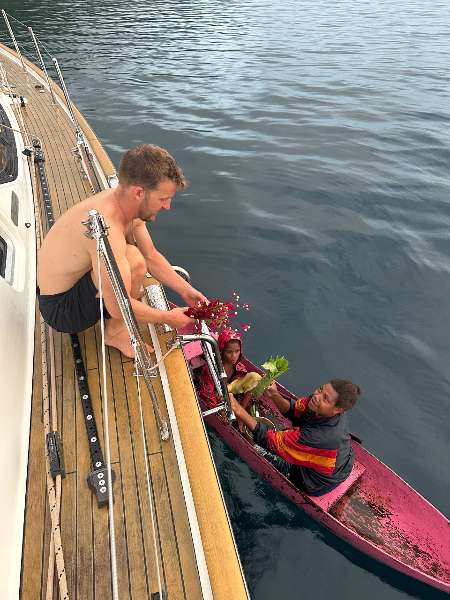
On the NW corner of the bay on the peninsula lives Hilda. Hilda greeted us when we first arrived in the Solomon Islands. She came over in a dug out canoe and gave us some flowers as a welcome to her country. It was very touching. Over the next few days we developed a friendship. Hilda can arrange local activities including: –
- Local dancing
- Necklace and basket making
- Local cookery (which uses hot stones and is quite fascinating)
- Feather money
- Local traditional clothing making
Hilda can be contacted:
- by email at: [email protected]
- On Facebook: Hilda Joe Kola
- By Mobile phone: 7970141
She is keen to start a Lata Yacht Club and would welcome help and advice from anyone willing to help get this up and running.
Guadalcanal
On the SE corner of Guadalcanal Island are the islands of Marapa. They are some of the most beautiful we have visited anywhere in the South Pacific and we strongly recommend a visit.
Pai Pai island is a truly stunning island. The anchorage was great with good sandy holding. It is well protected from the SE trades and from swell with calm, flat and clear waters and sand bars. There is a strong current at maximum tidal flow, but it is very much worth staying here.
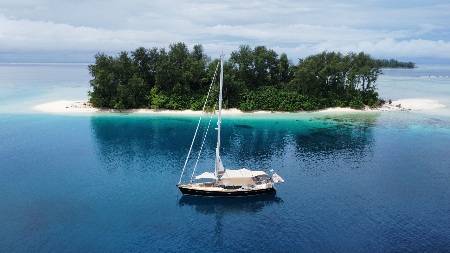

However, as everywhere in the Solomon Islands, as soon as you arrive you must ask permission from the land owner. If you fail to do this you may find yourself in a very uncomfortable confrontation and not feel safe.
The land owner of Pai Pai Island is the Tarakau Tribe. Your contact is Joaquim Pehu or, more easily to find, his sons Joaquim and Brown. Don’t wait for them to come to you, go and find them with some gifts and ask for their permission. They live nearby on Tawa ihi Island at 9°50.444’S 160°50.732’E.
We formed a good relationship with Joaquim and his sons and felt safe the whole time we were here. However, one day we stupidly left a bag unattended on the beach and a local sneaked through the bushes and stole 2 iPhones. We told Joaquim and he made sure both phones were returned to us within less than 24hrs. So don’t leave anything unattended in the open!
A great contact here is Elijah at Conflict Bay Lodge. He can be contacted in advance at [email protected]. Elijah can be totally trusted. He is very knowledgeable, speaks excellent English and has a kind soul. He arranged an amazing meal for us in his home of lobster, mud crab and fish, which was a real highlight of our time in the Solomon Islands. He is also a great source of local information.
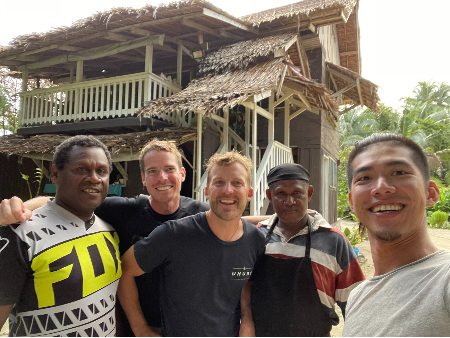

Nggela Islands
This was one of the most special and memorable anchorages of our time in the Pacific. We would go so far as to say this is one of the rare “must-visit” anchorages. Why? Firstly, it feels very safe. There are two families who are keen to make yachts safe and who understand the benefits they bring.
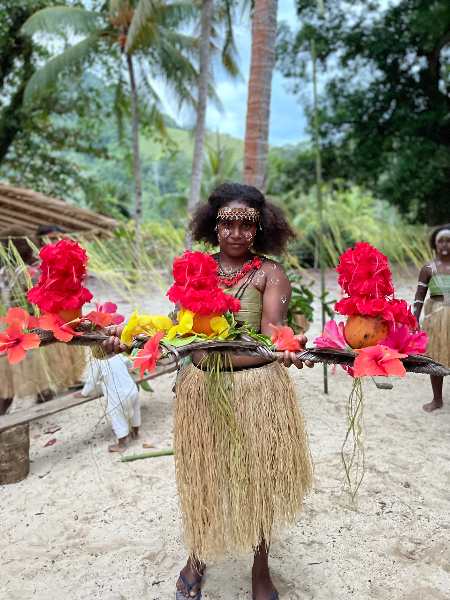
Secondly, the wreck of the MS World Discoverer is as photogenic as it is fun. It’s got orchids and greenery sprouting out of it and is located on a sandy lagoon surrounded by coral. The local land owner, Patrick, has installed a zip line and swings from the wreck, which makes it feel almost like an isolated water park! We spent three days playing there and never got bored.
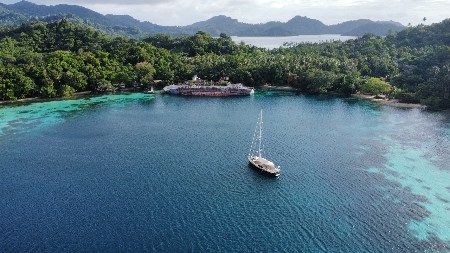

The chief of the village, John Ruka, is almost obsessed by yachts! He welcomed us with a flower display that was better than anything in a florist shop back home. On our last night he prepared a mini festival for the three of us, with welcome drinks, a meal on flower plates and Kastom dancing by a fire. It was all very special and a lot of laughs. John can arrange food, dancing, BBQs, tracking or be a guide for a tour of the island, villages or even further afield.
The bay is 20-30m deep and John has installed a mooring for yachts. We scuba dived the mooring down to the 33m base and inspected the whole set up. As of August 2023 we would be happy to moor our 450 tonnes boat there in moderate conditions, but check for yourself. We gave John a gift to enable him to install a second quality mooring. The mooring is a little exposed to the SE winds, but there is little fetch for any wave formation.
Anchoring is not recommended
I would highly recommend yachts not to anchor there – we did and then dived to see that we had put our anchor down amongst beautiful coral – the mooring is the way to go if you don’t want to destroy the coral. Also, John is happy to care for any yachts whilst the owners fly abroad. It’s a short banana boat ride to Honiara and a flight out and I would trust John to take care of a yacht if you needed to. He is also building some huts for visitors and has a guest book that he has been keeping since 1975 for visiting boats.
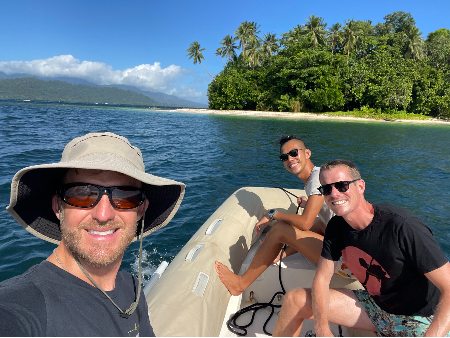

Try to visit here when the SE winds are not too strong. Also, do not anchor in the pool next to MS World Discoverer, no matter how tempting it looks. We dived the pool and the sand holding to the south is a terrible sponge which offers no holding to even the best anchors. This leads you to drag onto the coral to the north of the pool, which is a stunning field of endless plate coral that is so delicate a chain would wipe out large swathes. The only option in this pool is to drop anchor by the beach and stern tie to the large tree to the north of the wreck. This could be amazing, but we didn’t try it.
It’s worth mentioning that there is a high quality cyclone hole in Roderick Bay that looks suitable for weathering a serious event.
Contact John in advance via Facebook and he will have an amazing welcome for you. We had some friends on a boat follow us and when they arrived John had coconut cocktails and a fire and dancing and they felt they had arrived in Paradise.
Banana boats to Honiara
John and his brother arrange banana boats to Honiara and back. We chose to go on the banana boat to get cash and provisions. Its about an hour and a half in the boat and we were really pleased that we did because we stayed away from the capital – we never went to an urban centre with our boat Uhuru – we got cash, we got provisions and we had a really fun day out.
Our friends who went to Honiara on their boat didn’t have any problems in Honiara there, but on the way there, they had an attempted boarding by a group of aggressive fishermen on a boat that were either drunk or drug affected. They (our friends) had to stand on the side of their boat and protect themselves with whatever they could and it really shook them up. Be aware that you do take a risk if you go close to urban centres.
Crazy river channel
There is a channel that runs between Nggela Sulu Island and Nggela Pele Island which looks like this crazy river. On Navionics it has no depth information. We went through it anyhow on our 2.7 metre draft boat – it never got shallower than 7 meters and it was incredible – it felt like we were on an Amazon cruise passing villages built on stilts. We can highly recommend this to anyone with a sense of adventure!
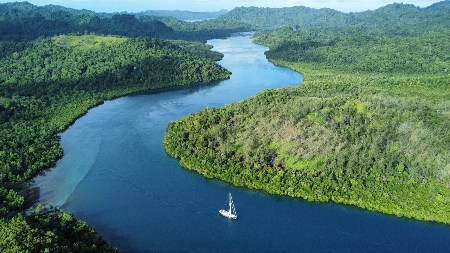

Russell Islands
These are famous for diving and we had pre-arranged with the local dive boat to use their mooring. North of Pipisala there is an island there where the dive boat moors. There are not many anchorages here – most of the places are 25-30 metres deep and then there’s reef. So we had to use their mooring. There are two moorings there and we were two boats, so we used both moorings.
We went to see the chief, got permission to be there, visited the village, went snorkelling and it was absolutely spectacular. We did a dive on the north of the island which is where the dive company that owns the moorings takes people diving and it was extremely impressive – lots of big schools of pelagic fish, sharks and tuna.
Diving the Lehru cut
Then we did the Lehru cut – which is a big cave which you can swim through with light shining through it. Again we asked permission from the landowner and we gave some gifts and gave a small charge per head. We had some friends who went there after us and felt uncomfortable and didn’t get to do any of the diving, we felt very safe and comfortable so I am not sure what happened with them.
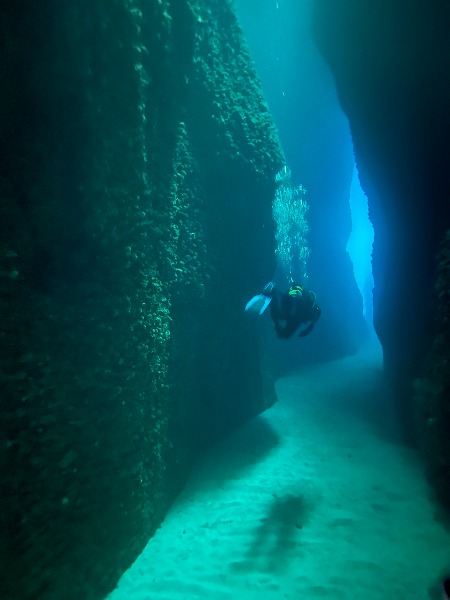

Morovo Lagoon
After that is the Morovo lagoon, which is as famous as it is meant to be. We wish we had spent longer there. The Mbili entrance is very famous and offers a very protected anchorage.
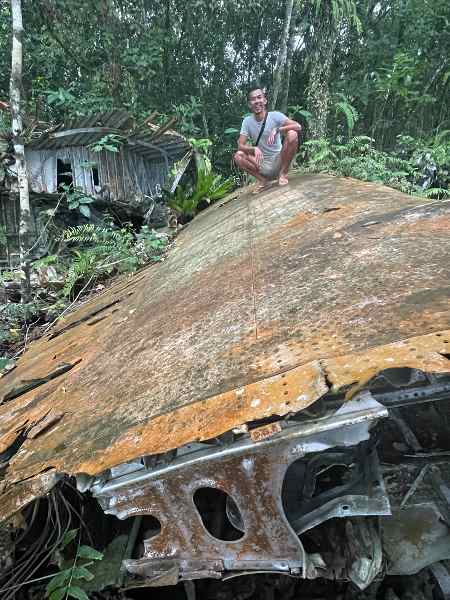
When we arrived, we had arranged to see some wood carvings. We thought we would see one or two carvers, but when we arrived there must have been 30 different carvers from the area exhibiting for us. About 1000 items were put out just for our boat, but very high quality, the very best we had seen in our travels so far.
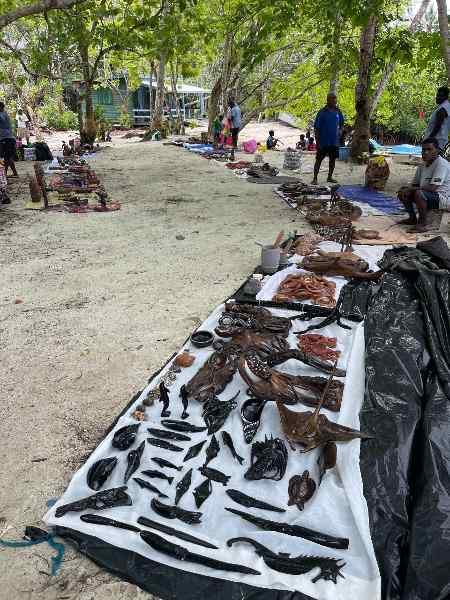
Matiu Island
North of the lagoon is Matiu Island, one of the most protected anchorages that we had in many months. We anchored in four to five metres on sand. We were totally protected from the trade winds and wish we could have stayed there longer. There is really good diving and snorkeling in the pass north and south of the anchorage, so there is a lot to do. It has a big white sand beach – just paradise.
Uepi Island
Important note: on the north side of Uepi, there is a really posh resort called the Uepi Island Resort. Sometimes cruisers, like us, think that after two months at sea, cruising remote places and being in the middle of nowhere, we can maybe have a nice dinner or a drink at the bar or some element of civilisation at resorts like this.
We had read that it wasn’t very friendly, but we thought we would give it a go. Unfortunately, as soon as we arrived, the staff asked us to leave. They were very apologetic and sorry but the Australian owner of the resort apparently just doesn’t want anyone around. We thought maybe it would be different if we were nice and friendly, but it wasn’t so it is not worth going there. You will have to leave and find somewhere else to anchor and it’s not pleasant.
Chuchulu
As you head South west between the two main islands, you go through a famous part of the lagoon called Chuchulu, which is a bit like Raja Ampat in Indonesia with hundreds of islands.
To the west is Tetepare Island, the largest uninhabited island in the Southern Hemisphere which has not been logged and is a totally wild and pristine wilderness. There is an eco lodge on the western side which I can really recommend for a visit. They are undertaking a host of ecological programs so you can see turtles being hatched and swim with dugongs – amazing.
Off the coast of New Georgia there are loads of things to do including a visit to Noro town and a couple of outstanding lagoons, but we didn’t have time to go to any of these.
Gizo
We ended up in Gizo which is the major tourist place in the Solomon Islands. We anchored outside the Sanbis resort and the Fat Boys resort. Both were really friendly and we had pizzas and cocktails and we were really happy that for the first time in a couple of months we could eat food made by someone else.
The anchorage was quite exposed to the trade winds and fairly unpleasant, but there was good snorkeling. Gizo airport is very close, so easy for a crew change to fly in and out.
Re-fueling
We checked out here and also re-fueled and stocked up on provisions. When we went to re-fuel we thought we would anchor somewhere hidden, off the town, and we were told that it was unsafe and the locals seemed quite concerned, so the lady that owned the fuel station said we could stay on the dock for the night.
The fuel station is owned by an American/ Solomon Islands family, so it was nice and secure and the security guard watched us all night from the dock. We gave him some food and we felt very safe so that ended up being wonderful. We told two other boats about the situation and they were able to re-fuel there and do the same as we did and they also felt very safe.
The fuel was good quality and not a bad price and they pump it into your boat from the dock.
No checking out issues
Customs at Gizo were really fine and there were no issues with checking out formalities. They had been emailing us before our arrival there and we just had to pay the entry fee that we didn’t pay on entry (at Lata) and the exit fee, both of which were minimal.
There’s a lot of chat on FB about customs/immigration personnel trying to charge a 34US$/metre fee, which I understand used to be charged, but which is no longer an official charge. They never tried to charge us, but our buddy boat friends who we were travelling with did have the charge tried on them. However, when they mentioned they were going to post it on FB, the official relented on making them pay. It was our understanding that this charge has been discontinued, so do not pay it.
There was no biosecurity check in Lata and none in Gizo, but we know other yachts who were checked. However, we had regular email with customs in advance and were told that as long as everything we had stayed on the boat, they weren’t worried.
Not enough time…
We arrived in Lata on 13 August and left on 13 September, nowhere near enough time to fully appreciate these islands. We sailed everywhere, except from Morovo lagoon to Gizo because there are such high volcanoes around the area that there was a complete wind shadow. Our buddy boat took the northern route and sailed the whole way, they didn’t have to use their engine once.
So, if you want to go to the Solomon Islands, you will not be disappointed – just be prepared, do some forward planning and you will be rewarded with one of the last relatively untouched areas – both geographically and culturally – on the planet.
If you need any further tips you can message Uhuru of London on WhatsApp +447779335417.
James Ashwell
SV Uhuru of London
………………………………
About the Author
James Ashwell and his crew left London in 2017 on a “lazy circumnavigation”. They have spent the past five years cruising the Pacific and are now cruising through Papua New Guinea, heading for Indonesia.
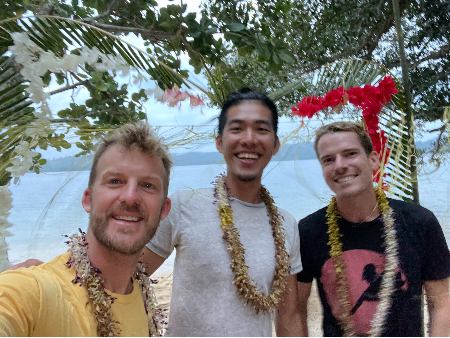

………………………………
Other Noonsite reports from James:
………………………………
The opinions expressed in this article are the author’s own and do not reflect the view of Noonsite.com or World Cruising Club.
………………………………
Find out all news, reports, links and comments posted on Noonsite, plus cruising information from around the world, by subscribing to our FREE monthly newsletter. Go to https://www.noonsite.com/newsletter/.
Related to following destinations: Central Province, Choiseul Province, Guadalcanal, Lata - Ndendo Island (Santa Cruz Islands), Outer Islands/Atolls (Solomon Islands), Russell Islands, Solomon Islands, Western Province (New Georgia)
Related to the following Cruising Resources: Circumnavigation, Circumnavigation, Off the Beaten Path, Pacific Crossing, Pacific Ocean South, Routing



